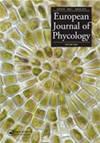Oedooniales线粒体基因组结构、系统发育分析和替代率估计
IF 1.7
4区 生物学
Q2 MARINE & FRESHWATER BIOLOGY
引用次数: 1
摘要
摘要Oedogoniales目包括Oedogonium属、Oedocladium属和Bulbochaete属三个属,它们是根据传统形态学标准分类的,包括600多个已描述的物种。这一群体在虾青素生产和能源部门具有重要的经济意义。然而,到目前为止,只有一个线粒体基因组(线粒体基因组)被报道。本研究测定了7种Oedogoniales物种的线粒体基因组,其中包括6种Oedoonium物种和Oodocladium prescotti。新确定的有丝分裂基因组与先前报道的直柱球藻(Bulbochaete rectangularis var.hiloensis)有丝分裂染色体组之间的比较分析表明,所有8个有丝分裂基因都包含12个蛋白质编码基因(PCG)和2个rRNA;然而,有丝分裂基因组在基因组大小、GC含量、tRNA、非编码区和内含子方面存在差异。对八个有丝分裂基因组的同源性分析显示,总体上具有高度的同源性保守性,并有一些重排和反转。8个有丝分裂基因组的平均核苷酸同一性(ANI)分析表明,齿网Oedonium与Oodonium sp3具有较高的相似性(ANI96.32%)。系统发育结果表明,Oedonium是多系的,Oedocladium的物种与Oedoniu聚在一起,而B.rectangularis var.hiloensis的位置不确定,导致系统发育结果不一致。对替代率的统计分析表明,这三个属之间没有显著差异,基于分支模型的dN/dS比率表明,前叶牛蒡和黑腹牛蒡的cob、cox1和nad4被认为是快速进化的基因。这些发现表明,Oedogoniales的传统分类学并没有定义自然类群,Oodocladium和Bulbochaete的物种可能经历了快速进化。本文章由计算机程序翻译,如有差异,请以英文原文为准。
Mitochondrial genome structure, phylogenetic analyses and substitution rate estimation of the Oedogoniales
Abstract The order Oedogoniales comprises three genera, Oedogonium, Oedocladium and Bulbochaete, which were classified based on traditional morphological criteria, and includes more than 600 described species. This group is economically important in astaxanthin production and the energy sector. However, only one mitochondrial genome (mitogenome) has been reported so far. This study determined the mitochondrial genomes of seven Oedogoniales species, including six Oedogonium species and Oedocladium prescottii. Comparative analyses between the newly determined mitogenomes and the previously reported Bulbochaete rectangularis var. hiloensis mitogenome showed that all eight mitogenomes comprised 12 protein-coding genes (PCGs) and two rRNAs; however, the mitogenomes differed in their genome sizes, GC content, tRNAs, non-coding regions and introns. Synteny analysis of the eight mitogenomes revealed a high degree of syntenic conservation in general, with some rearrangements and inversions. The average nucleotide identity (ANI) analysis of the eight mitogenomes indicated Oedogonium dentireticulatum showed high similarity with Oedogonium sp3 (ANI of 96.32%). Most of the PCGs of the eight mitogenomes presented the conventional start codon ATG and stop codon TAR (TAA/TAG/TGA), and the synonymous codon preferences were conserved. Phylogenetic results indicated that Oedogonium was polyphyletic, and species of Oedocladium clustered with Oedogonium, while the position of B. rectangularis var. hiloensis was uncertain for the incongruent phylogenetic results. Statistical analyses of substitution rates demonstrated no significant differences among the three genera, and the dN/dS ratios based on branch model showed that cob, cox1 and nad4 of Oedocladium prescottii and B. rectangularis var. hiloensis were putative fast-evolving genes. These findings suggested that the traditional taxonomy of Oedogoniales did not define natural groups, and that species of Oedocladium and Bulbochaete may have undergone rapid evolution.
求助全文
通过发布文献求助,成功后即可免费获取论文全文。
去求助
来源期刊

European Journal of Phycology
生物-海洋与淡水生物学
CiteScore
4.80
自引率
4.20%
发文量
37
审稿时长
>12 weeks
期刊介绍:
The European Journal of Phycology is an important focus for the activities of algal researchers all over the world. The Editors-in-Chief are assisted by an international team of Associate Editors who are experts in the following fields: macroalgal ecology, microalgal ecology, physiology and biochemistry, cell biology, molecular biology, macroalgal and microalgal systematics, applied phycology and biotechnology. The European Journal of Phycology publishes papers on all aspects of algae, including cyanobacteria. Articles may be in the form of primary research papers and reviews of topical subjects.
The journal publishes high quality research and is well cited, with a consistently good Impact Factor.
 求助内容:
求助内容: 应助结果提醒方式:
应助结果提醒方式:


